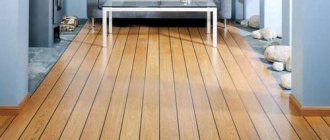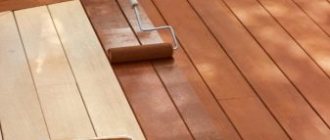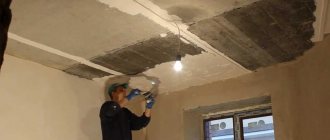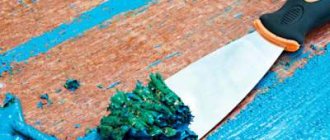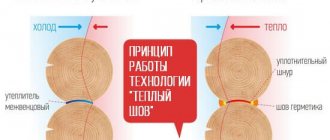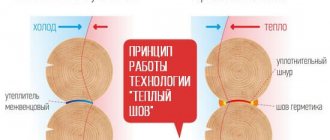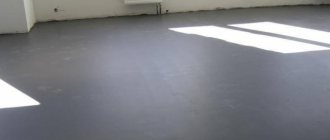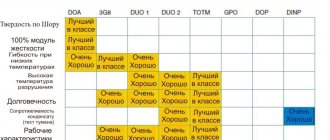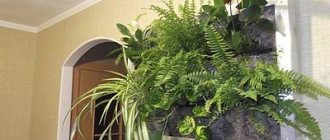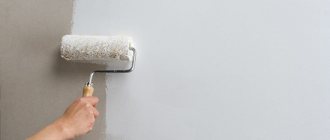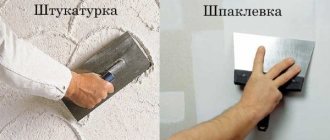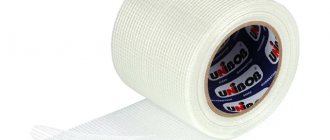Indications for use
Wood putty for floors is necessary to solve the following problems:
- eliminating cracks and joints;
- correction of depressions, deformations;
- elimination of height differences;
- leveling the surface for painting, applying varnish;
- increasing the water-resistant characteristics of wood;
- increasing the shelf life of plank coverings;
- improving surface adhesion characteristics before dye treatment;
- reducing the costs of paint and varnish products.
Independent preparation of the composition
When deciding how to putty a wooden floor before starting to lay the laminate, many consumers come to the conclusion that it is better to prepare the mixture themselves to complete the work. The whole essence of the process comes down to the fact that the floors must first be strengthened (if there are “walking” boards), then a frame made of thin bars must be built, and then the free space between the joists must be filled with a composition made on the basis of PVA. This is a great way to level the floor before laying laminate or linoleum.
First option
To prepare the composition you will need a sufficient amount of fine wood sawdust and PVA glue. The thick mixture is poured between the bars, leveled using a rule or a large spatula and allowed to dry thoroughly. After drying, the resulting surface (which can be considered ready for laying a new coating) will be quite hard and durable, there will be no cracks or irregularities left on it.
Second option
Animal glue (10% of the total mass), liquid drier (2.5%) and turpentine or glue kerosene (12.5%) are used. This means that to prepare 1 kg of the mixture you will need 200 g, 50 g and 250 g of the listed substances, respectively. This putty needs to be welded:
- Heat animal glue and add soap to it.
- Slowly, stirring constantly, add drying oil, turpentine and drier into the resulting hot mixture.
- When the mixture thickens and becomes a homogeneous mass, carefully introduce a small amount of chalk.
Continue stirring the mixture while heating until the putty begins to resemble thick sour cream. You can putty until the prepared putty begins to cool. To heat up the cooled mass, just use a water bath, which will ensure gradual and uniform heating.
It is important that the putty you prepare yourself meets the basic requirements for this kind of composition. It must be elastic and durable. In addition, the most important quality of such a mixture is high adhesion. It is this that guarantees a long service life of the floor without swelling and cracking. An equally important detail is the homogeneity of the mass.
Third option
There is another simple recipe for making wood putty with your own hands. It is prepared on the basis of PVA glue. To implement your plan you will need:
- PVA glue;
- water;
- dry mixture for finishing putty.
It is necessary to pour glue into the prepared container (about 1/3 of the total expected mass of the composition), add 2/3 of water to it, then gradually introduce any finishing putty, remembering to stir constantly. Dry putty should be introduced in small doses, mixing thoroughly until a homogeneous elastic mass is obtained.
Now it can be applied evenly to the surface to be restored and allowed to dry completely. You can begin processing with fine sandpaper no earlier than after 12-15 hours. After restoration using such a mixture, the old surface will look perfect, and any paint will fit perfectly on it.
Types of putty for wooden floors
Putty for wooden floors is produced in several varieties, differing in the type of base.
The list of popular mixtures includes:
- solvent-based;
- water based;
- polymer;
- latex;
- oil based, etc.
Putty is available in different colors and textures. Manufacturers offer a range of wood shades (oak, pine, birch, beech, etc.).
Solvent putty
Solvent-based wood floor putty is fast drying. Essential resins are used as a binding component, which are diluted with organic solvents. The putty also contains wood dust. Manufacturers offer the material in the form of a colorless base that can be colored with pigments. Ready-made tinted formulations are also available.
Advantages of solvent-based putty:
- increased strength;
- easy application on a wooden base;
- quick drying;
- slight shrinkage;
- natural shades.
However, you need to take into account the sharp odor of the material during application and the need to organize ventilation of the room before drying.
Water based putty
You can putty the floor with a water-based mixture. The material is environmentally friendly, safe to use, easy to apply, aesthetically pleasing, and has no pungent odor. After application, the remaining mixture is removed with acetate or turpentine. The advantage of the composition is the ability to qualitatively eliminate defects on the floor, the water resistance of the mixture, and a long service life.
The material can withstand changes in temperature conditions and protects wood flooring from possible fire. The putty is elastic, suitable for modeling the required surface texture.
Good adhesion properties of the mixture allow it to be applied to polished surfaces and to eliminate cracks in wooden floors. However, it is necessary to take into account the slow drying time of the putty.
Oil based
Oil-based putty is most suitable for wood. The composition also includes water and chalk. The mixture is suitable for finishing different types of wood floors before painting. The putty has water-repellent characteristics, can withstand changes in temperature conditions, does not crack or crumble.
The material is presented in a wide range of shades and textures similar to natural wood. The composition is characterized by high strength and durability. Manufacturers offer oil-based formulations in tubes weighing 1-20 liters. It is necessary to take into account the long drying time of the coating; to eliminate the strong odor, you will need to ventilate the room.
Polymer acrylic
Polymer wood putty can be used in repair and construction work. The material is in demand due to its versatility (suitable for rooms with humid and dry air) and high performance characteristics. The composition is plastic, durable, does not shrink, can withstand mechanical loads and changes in temperature conditions. The putty contains plasticizers and polymers. Due to its high elasticity, the composition is used for sealing cracks in wooden floors, joints of slabs, and boards in parquet.
The material is suitable for application in 1 layer and retains its shape after drying. The service life of the coating is 3-10 years without the formation of cracks or chips. Polymer putty is available in a wide range of shades and dries quickly. Its cost is higher than that of other compounds. It must be taken into account that the polymer mixture cannot be used when finishing hard wood or cork flooring.
Acrylic putty is available in light shades (white, light oak, pine). The composition has the consistency of sour cream and easily eliminates defects and chips. The hardened material is securely fixed to the wooden base. The advantage of the composition is good adhesion, strength after drying, and the ability to form a dense layer of up to 3 mm.
Acrylic putty is optimal for preparing wood floors for painting with water-dispersed paints. The product is environmentally friendly, does not emit toxins, therefore it is optimal for finishing residential spaces.
It must be taken into account that these putties are not used at sub-zero temperatures. The acrylic coating will need to be sanded thoroughly with sandpaper.
Criterias of choice
How to make the right choice between dozens of floor leveling putties from different manufacturers that differ in composition. First of all, you need to take into account the following criteria:
- The putty material must be soft and have great penetrating ability to best fill uneven floor surfaces;
- the putty should have a uniform consistency and not fall off the spatula at the time of application;
- the hardened putty layer should have a strength less than that of wood
- the putty should not crack or crumble during drying;
- The composition should not harden too quickly, otherwise it will be difficult to apply and also sand.
Putty for a wooden floor must be soft and uniform in consistency.
The main condition for selection is that the composition must be compatible with the floor material and with the paint or varnish intended for use.
If you are not sure of compatibility, you should test:
- buy a minimum package of putty and paint;
- a small area of the floor in an inconspicuous place should be cleaned, degreased and dried;
- Apply the selected putty to this area, seal all irregularities, cracks and crevices in the wooden floor;
- let the coating dry;
- sand and polish if necessary;
- paint or varnish.
If the result suits the owner, you can purchase the full amount of materials and finish the entire floor.
Manufacturers and prices
Manufacturers produce putty in a wide range of colors, textures, and compositions.
The list of materials in demand includes:
- Berger Aqua-Seal Pafuki (Germany). Putty for wooden floor coverings, parquet boards. The material is high-quality, durable, packaging is offered at a price of about 1500-1800 rubles. The dry powder is diluted with water according to the proportions specified by the manufacturer. Consumption is carried out at the rate of 1 bank per 1 m².
- Berger Aqua-Seal Spachten Gel. The putty is characterized by quick drying and is made on a water basis with the addition of acrylic-polyurethane filler. The material is odorless and non-flammable. The cost of production is about 2800 rubles.
- Berger Pafuki-Super. The material is made on the basis of solvents and is used for sealing gaps and cracks in the floor. The cost of packaging is average - about 1100 rubles.
- Bona Gel. Water-based dispersion gel putty, contains polyurethane fillers. It is easy to apply, dries quickly, and is used to eliminate minor defects, cracks, scratches, and improve the aesthetics of the floor. Consumption is carried out at the rate of 1 liter per 25-35 m² when applied in 1 layer. The price of the package is about 1400-1500 rubles.
- Bona Mix&Fill. Water-dispersion putty is intended for finishing floors made of different types of wood. The cost of the material is about 600-700 rubles.
- Bona Mix&Fill Plus. The material is a binder for sealing defects, cracks in the floor, and eliminating gaps between parquet planks. Packaging price - 1200-1300 rubles.
- Domallux Capon Szpachla. Nitro putty is designed to eliminate cracks, voids, and defects from mechanical damage in floors. The material contains UV filters. The putty is easy to apply and dries quickly. Wood dust can be added to the mixture to give the putty a shade close to the color palette of the floor. Wide depressions are filled in 2-3 layers. After drying, the coating is treated with sandpaper. Treated surfaces can be coated with varnish or primer. The price of the package is low - about 800 rubles.
- Loba Ws Easy Fill Plus. The putty mixture is water-based and dries quickly. Acrylotate is used as a binding ingredient. The price of the package is 1200-1300 rubles.
- Loba Ws Topgel. Water-based putty gel based on polyurethane-acrylic. The material is easy to apply and has a light texture. Packaging price - 600-700 rubles.
- Lobadur Fugenkitt Losung. Solvent-based material designed to eliminate defects in wood flooring. A shade similar to the base can be achieved by adding wood dust. The putty is suitable for different types of wood, dries quickly, does not shrink, and is easy to sand. Used to treat floors before applying varnish and oil-based finishes. Consumption is 80-100 ml per 1 m². A layer of 2 mm dries in 30-50 minutes. Packaging price - 950-1000 rubles.
- Pallmann Allkitt. One-component putty mixture. The material contains alcohol solutions. Package price - from 850 rubles.
- Tover Ilrostucco Rs 30. Water-based putty, can be mixed with wood dust to give the desired shade. The price of the package is about 700 rubles.
Execution of work
Putting the floor with your own hands is an activity that requires certain skills. With the help of putty, you can qualitatively update the existing floor covering made of wooden boards during cosmetic repairs. Even re-applying the paint composition to the surface requires preliminary puttying, which will help make the floor even and smooth.
You can only work on a dry wooden board, from which not only dust and dirt, but also the previous coating has been removed. When preparing the floor for puttying with your own hands, it is necessary to degrease it.
The putty is applied in a thin layer using a special steel spatula. It is important that during the work the mixture fills all existing cracks and cracks. You should pay attention to the thickness of the putty layer, because after complete drying the floors will have to be sanded. The number of layers of the applied composition depends on the degree of damage to the coating. Each subsequent one (after it has completely dried) is sanded again. This continues until there are no bumps or depressions left on the floor surface.
Using wood putty is not always suitable for existing flooring. Therefore, after all the cracks between the boards have been filled, sheets of plywood are laid on top of the old covering, and linoleum or laminate is laid on them.
Making your own putty to level a wooden floor
Puttying a wooden floor can be done with homemade solutions.
To work you will need:
- drying oil (1 kg);
- glue 10% (200 g);
- drying agent chalk;
- turpentine or varnish kerosene (250 g);
- kerosene dryer (50 g);
- liquid soap.
The glue is heated on the stove while stirring, and other ingredients (except chalk) are added to the composition. The solution is stirred. Chalk is added at the final stage, the proportions are determined independently to obtain a creamy consistency. The mixture is kept warm during the mixing process. It is optimal to use a steam bath.
Properties of polymer putties
This is another tool that is advisable to use when working with wooden floors . In this case, the water base is supplemented by polymers. The composition is characterized by a high hardening rate, environmental safety, absence of destructive processes after long-term use and practicality. When choosing which type of putty to use in a residential building or apartment , you should pay attention to polymer mixtures.
They are good not only for the absence of toxic fumes, but also for their ability to protect the edges of wooden finishing elements from clogging. This material does not collect dust , which is convenient during the installation process. Such coatings also perform their direct function of filling defects flawlessly, eliminating even deep cracks and dents. But there are also restrictions on use. Polymer putty is not recommended for use when processing floorboards and cork floor coverings .
Puttying a wooden surface to seal floor cracks under linoleum and parquet
Sanding a wooden floor under laminate is done with a large volume of mixture. It is optimal to use putty with PVA glue and sawdust or ready-made mixtures.
Stages of work:
- Before puttying, the floors are cleaned of old finishing materials, and loose boards are secured with self-tapping screws.
- The slats are fixed on the base maintaining a gap of 35-50 cm, the elements are used as beacons.
- The symmetry of the slats is checked with a building level.
- The mixture is applied between the beacons in 2-3 layers. Each layer is dried.
- After the coating has dried (48 hours), grouting is performed.
- At the final stage, painting or laying of a decorative coating is performed.
How to putty
The process of puttying a wooden surface is practically no different from puttingtying ordinary walls.
- Surface preparation
- Padding
- Putty 2 layers
Surface preparation
The first step is to prepare the surface. Many inexperienced “masters” do not pay due attention to preparing the surface for putty, believing that putty will cover all the unevenness. Before applying putty, it is imperative to prepare the surface. Namely, remove old paint, dust, dirt, nails and other metal objects.
Where there were metal objects, it is advisable to cover the holes with enamel. This is necessary so that rust does not come through the putty when it is applied. After this, brush over the surface to remove small, stuck particles of debris, and then wipe with a slightly damp sponge.
Surface priming
The next stage, as in the case of puttying walls, is applying a primer. Primer, mandatory work before puttying. A primer is necessary for better adhesion of the putty to the surface, as well as for additional protection of the wooden surface from rot and mold. Choose a primer with a similar putty composition. If your putty is oil-based, then use a drying oil-based primer. For nitro putty, use a similar primer composition.
Puttying the surface
After the primer has dried and polymerized (from 4 hours or more, depending on the composition and manufacturer), first you need to fill up the cracks and other irregularities.
The first layer of putty should be no more than 2 mm thick. We are waiting for the mixture to dry. We correct it and smooth it out with sandpaper. Apply the next layer of putty, leveling the surface as much as possible. The second layer should be no more than 1.5 mm thick. After the second layer has dried, we clean the surface with sandpaper.
Puttying wooden surfaces is a rather troublesome process, but it is worth it to “breathe” new life into an old item. Follow the instructions of the manufacturer of the material you have chosen and there will be no problems with completing the work.
Inspiration and easy repairs for you!)
Subscribe to our Yandex.Zen channel
What is wood putty
Wood putty is a mixture of several mineral or polymer components intended for repairing or finishing a wooden base. Some are used for plastic materials. A special feature is increased adhesion to wood and surfaces that do not absorb moisture.
The mixture is an emulsion with a viscous consistency, reminiscent of sour cream with 20% fat content.
It seems that the composition is made only for wood. But it is not so. Putties are made for:
- puttying cracks or seams, wooden, MDF, PVC walls, furniture facades;
- filling the wooden base of internal and facade surfaces;
- spot repair of parquet or laminate flooring;
- masking damaged surfaces;
- restoration of wooden beams, plywood sheets.
You should not use wood putty to repair concrete bases, as adhesion will be lower and such repairs may not last long.
Requirements for putties
Wood putty is an emulsion used on surfaces bearing different mechanical loads, indoors and outdoors. Therefore, the material must meet many requirements:
- Fraction. For convenient application of a thin layer with spatulas, the mixture should consist of a fraction of no more than 0.2 mm.
- Adhesion. Wood is a difficult material to process in construction. The putty should be created on the basis of materials that adhere well to it, for example, acrylate, PVA, alkyds, epoxy resin.
- Elasticity. Board or plywood are deformable bases that can change shape under load. Therefore, the composition for painting or restoration must be able to bend.
The putty is applied in a minimal layer. Therefore, it must be non-shrinking after drying.
